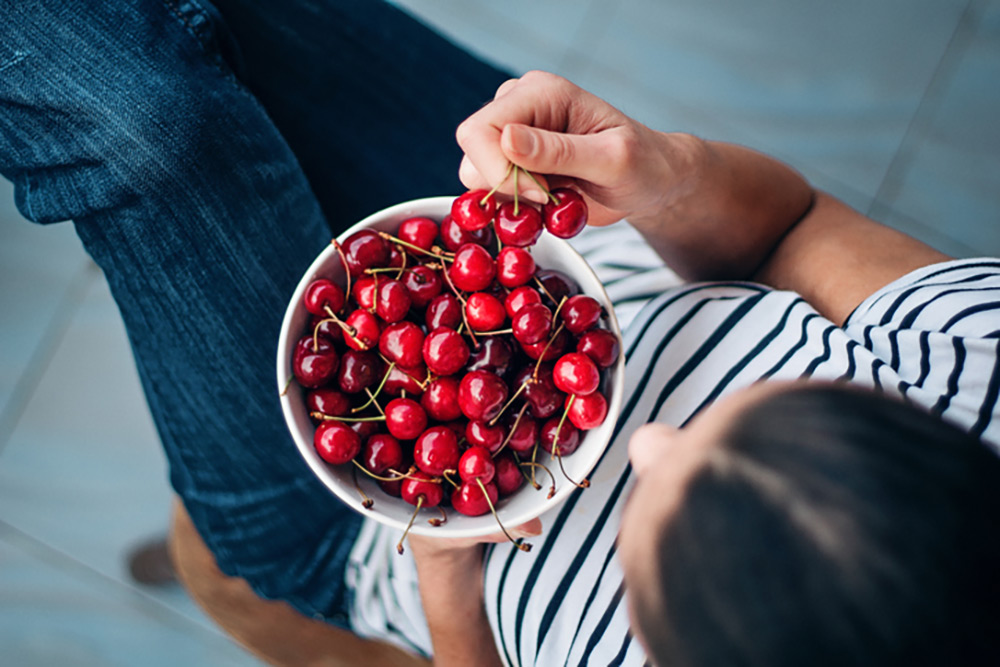
iStock
By Mary Carpenter
A FEW seconds after Cambridge, Massachusetts sourdough bread entrepreneur J.G. tentatively took a nibble of a small cherry, he said,” yup, it’s happening”— a tingling feeling in his lips and mouth that started occurring in his mid-50s when he eats cherries and certain types of apples. Called both oral allergy syndrome (OAS) and pollen food allergy syndrome (PFAS), such reactions develop in about 70% of people who have seasonal pollen allergies: specific grasses, weeds or trees set off “cross-reactive” immune responses to specific fruits and vegetables. “Cherry allergy most often occurs when the immune system mistakes similar proteins found in cherries for those present in certain pollens,” according to the allergy-care company Wyndly. For some people, the reaction occurs only with raw cherries, because cooking can denature or render non-reactive the proteins responsible; and those with cherry allergy may also react to other fruits and nuts, which is called the Pollen Fruit syndrome. Foods that can be cross-reactive along with cherries include apples, peaches, plums, nectarines and almonds.
Most PFAS are a contact allergy, causing allergic reactions on the skin—like poison ivy—that primarily affect regions coming into direct contact with the specific food, according to the American Academy of Asthma, Allergy and Immunology. In cases of PFAS, itchiness or swelling of the mouth, face, lip, tongue and throat can vary from episode to episode, from person to person—and can occur with the fruit’s skin but not its pulp or depend on the ripeness of the fruit. And while symptoms most often are mild and brief, and occur directly after eating, reactions can arise hours later and be more severe—including swelling of the throat—and in rare cases, progress to anaphylaxis.
True food allergies—most commonly to shellfish, followed by peanuts and tree nuts—affect the whole body and have been in the news recently with the approval of “neffy,” epinephrine nasal spray, as an easier delivery method than the epi pen for emergency treatment of life-threatening allergic reactions while awaiting medical care. Like PFAS, systemic immune reactions can also range from mild, such as hives, to life-threatening very low blood pressure or swelling in the throat that makes breathing difficult. Notes ER department director Josephin Mathai at HCA Florida St. Lucie Hospital, “Allergic reactions are kind of like a spectrum…having more than one of these symptoms at a time can be cause for concern…if you have a rash and vomiting, you should go to the ER.”
PFAS can occur any time of year—although incidence and severity might increase during pollen allergy seasons—and is the most common food allergy among adults, with prevalence that increases as populations age. According to pediatric clinic researchers in Parma, Bari and Bologna, Italy, PFAS can arise starting in childhood among those suffering from pollen-induced allergic reactions.
Regional dissimilarities in PFAS depend on the prevalence of different local grasses, trees and weeds, according to the Italian researchers. While cherries are most commonly implicated in Southern Europe—along with apples and peaches, and vegetables such as celery, carrots and tomatoes—in Japan, alder pollen cross-reacts with sensitization to apples; and Japanese cedar, with fresh tomatoes. And in Australian children, watermelon is the most common triggering food.
Cherry cross-reactivity in Northern Europe that comes from birch tree pollen sensitization can also occur with plant foods, such as tree nuts and fruits in the Rosaceae, or rose, family—along with cherries that includes apples, pears, almonds, peaches, apricots, plums, strawberries, raspberries and blackberries. But NYU Dermatologist Miriam Keltz Pomeranz warns in the Washington Post, oral itching from nut allergies “can be the same symptom you’d get initially from a true food allergy…And then you could get really sick the second time you tried it. “
Like all food allergies, PFAS is an immune system reaction that usually causes more serious symptoms compared to those from “food intolerance,” which is a gastrointestinal disorder. Although histamine is a signaling molecule that plays a role in many immune system reactions, “histamine intolerance” is a different and very rare reaction that occurs in about 1-3% of the global population. For these people, histamine builds up in the body, after which foods containing large amounts of histamine can cause upset stomach, headache or even allergy symptoms. Sometimes considered a pseudoallergy, histamine intolerance creates what looks like an allergic reaction to foods naturally high in the chemical histamine—with cherries, confusingly, appearing on different lists of both low- and high-histamine foods.
I have seasonal allergies that persist through growing seasons for trees, weeds and grasses, but so far don’t seem to have any cross-reaction allergies to related foods. I have wondered, however, if my gastrointestinal reactions to spicy and fried foods might be considered “food intolerance”—similar to what many people report as intolerance to gluten. In official recognition of the confusion around this topic, a group of Italian researchers have called for “a change in the public dissemination of the correct concepts related to the common question: Is it allergy or intolerance?” Meanwhile, I have begun to note slight tingling around the mouth when eating cherries—probably an unrelated phenomena, such as group hysteria or hypochondria.
—Mary Carpenter regularly reports on topical subjects in health and medicine.
